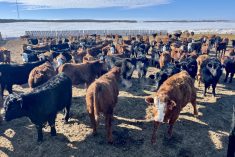One of the remarkable events of the past century related to ranching has been the genetic evolution of brood cows. The industry moved from scrawny Texas Longhorn-crosses with 25 per cent calf crops to hardy European and English hybrids producing 90 to 95 per cent calf crops with offspring weighing upwards of 50 per cent of the dam’s weight. The introduction of tough British and European crossbreds combined with a shift in production practices, such as putting up winter feed, contributed to the second generation of successful ranches.
The last 60 to 90 days before calving are arguably the most critical period in beef operations. That has always been true, but those days have grown more important. Changes in beef cow physiology and maternal habits coincided with much of the improvement witnessed in recent years.
During late gestation, cows undergo significant changes. In the final 90 days, they experience mammary development, produce colostrum antibodies and grow approximately 75 per cent of their calf. To put it into perspective, a calf typically weighs around 65-90 pounds at birth, meaning it gains 48-67 pounds during those last 90 days. That is truly remarkable.
Read Also

Why post-drought pasture management matters for beef farmers
Pasture management is always important, but it is especially important following a drought. During these challenging periods, pastures may suffer…
Body condition, nutrition and vaccinations all play crucial roles during this important period of development. We have come to understand that practices employed for a successful calf crop one year contribute to successful calf crops for generations.
Body condition scoring helps estimate an animal’s energy reserves. Producers can then adjust feeding programs to efficiently use available feed to maintain herd fertility and indirectly to maintain calf weaning weights. To feed efficiently over the winter and support rebreeding following calving, make sure mature cows go into winter with a minimum score of three. They should not drop below 2.5 during calving or the breeding season. Ideally, cows should have a body condition score three or better at calving. Cows in this condition tend to cycle faster after birth, have higher pregnancy rates and calve within a more predictable time frame.
Late gestation is the final opportunity to improve a cow’s body condition before the energy demands of lactation begin. Research indicates that cows need to gain at least 100 pounds during this period to support the calf’s tissue growth without sacrificing their own body condition.
When cows are severely nutrient-restricted, they may eventually stop supplying nutrients to the fetus to preserve themselves. More commonly, in cases of mild or moderate drought, cows will maintain pregnancy but sacrifice significant body condition to sustain their calves. This leads to underdeveloped calves with compromised immune function, growth issues, or carcass development problems that can persist throughout their lives.
Research from the University of Idaho shows that cows with a score of two or lower had a nine to 29 per cent lower pregnancy rate compared to those with a score of three or greater (using the five-point Canadian system). However, over-conditioned cows with a score of four or more may face an increased risk of dystocia and produce lower-quality and less colostrum.
Ultimately, the cow’s and calf’s status are intertwined. Healthy cows generally produce healthy calves.
As cows enter late gestation, their nutritional needs increase significantly. Energy requirements rise by 25 per cent, and protein needs by 10 per cent.
The developing fetus drives a higher need for macronutrients, such as calcium and phosphorus. Cows require increased levels of trace minerals, such as copper, selenium and zinc. Brood cows also need more vitamin A and D, which are crucial for proper fetal and immune system development.
University of Nebraska-Lincoln studies indicate that if producers retain heifers from nutrient-restricted cows, the negative effects could carry over to the heifers’ future calves, potentially affecting three generations of the herd. This is known as fetal programming. Fetal programming in theory means cattle management and nutrition may cause permanent fetal effects with long-term consequences for the unborn calf (Matthew Spangler et al.). Periods of limited nutrition produced calves with lower weaning weights, decreased immune response, lower carcass weights, lower fertility, reduced tenderness and meat quality over several generations.
In late gestation, the unborn calf relies heavily on the cow for nutrients as it develops muscle, fat, organs and carcass characteristics. If the cow’s nutrient intake is restricted due to factors such as drought, poor-quality grass or cold stress, the fetus’s nutrients may be limited. This negatively affects organ development.
The effects of nutrient restriction can extend across generations. Studies indicate that a nutrient-restricted cow affects not only her calf that year, but also the health and performance of following generations, including daughters, granddaughters and great-granddaughters. While crucial to provide protein and mineral throughout gestation, it is especially important during the last 60 to 90 days. More research is needed to fully understand long-term implications on profitability and performance.
Don’t forget about vaccination. Calves are born with an underdeveloped immune system. This is why colostrum is so vital for the transfer of passive immunity from the dam. Strategic vaccination before calving boosts protective antibodies that will be passed to the calf through colostrum.
Cows start pulling antibodies from their bloodstream and storing them in their mammary tissue about three to five weeks before calving.
To maximize antibody transfer and help prevent scours, consult your veterinarian about the most effective vaccination plan.

















